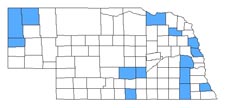Twelve-Spotted Tiger Beetle |
|
|
|
| |
|
|
 |
 |
| Cicindela duodecimguttata Say |
| Adult Length: 11 to 14.5 mm |
| Appearance: Adults of this species are dark brown to blackish in color with variable maculation. The maculation consists of separate humeral and posthumeral dots, a middle band which may be complete or fragmented, a reduced marginal band which may or may not be present, but if so it extends toward the posterior from the middle band, and an apical and subapical dot, which may or may not be fused. |
| Similar Species: This species could be confused with Cicindela repanda or C. longilabris. It is generally smaller than C. longilabris, and C. longilabris lacks an apical marking. It differs from C. repanda in being dark in color rather than bronze-brown, and it has more reduced markings. Where markings are similar, the marginal band in C. repanda extends virtually to the base of the posthumeral marking, while in C. duodecimguttata it terminates well short. Also, the middle band in C. duodecimguttata is somewhat upturned, while in C. repanda it is not. In addition, the ventral surface of C. duodecimguttata is predominantly blue, while in C. repanda it is more greenish. |
| Biology: This species occurs in moist areas and though it may occur alongside C. repanda in moist sandy areas, it is most common on moist silty and clayey soils. It can be found along stream shorelines, dirt trails through wetlands, and at new construction sites. Its preferred habitats in Nebraska are poorly known as it is only uncommonly collected in the state. It will often fly somewhat higher and father than C. repanda when alarmed. |
| Adult Life History: Adults emerge from the pupa from mid-August to early September and may be active into mid-October before overwintering. Activity resumes in March and April and peak numbers occur in April and May. Numbers gradually decline and adults are usually scarce by mid-July. It is a spring-fall species. |
| Larval Life History: Eggs are laid mostly from April to June. Most larvae reach the third instar by fall before overwintering. Pupation occurs in July of the following summer. Larval burrows occur in steep banks near streams (often in large numbers), especially in clayey, silty, or muddy soils, but may occur in sand. They likely occur in other areas with moist soils. |
| Biogeography: This species has only been collected in ten counties scattered across the Nebraska. It is likely overlooked and might be expected to occur in at least twenty counties. In North America it occurs from Newfoundland across southern Canada to northern Alberta and the southern shores of Great Slave Lake and south to northern Texas, Mississippi, Georgia, and North Carolina. It does not range west of the Rocky Mountains, but there is an apparent hybrid zone in eastern Colorado between it and C. oregona, a common western species. |
|




